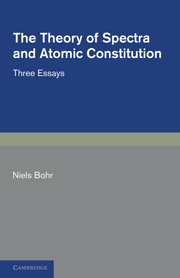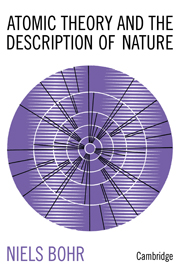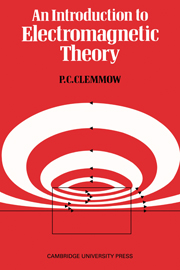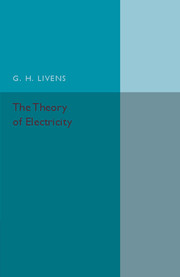The Theory of Spectra and Atomic Constitution
Niels Bohr (1885–1962) was a Danish physicist who played a key role in the development of atomic theory and quantum mechanics, he was awarded the Nobel Prize for Physics in 1922. First published in 1924, this second edition of a 1922 original contains three essays by Bohr dealing with the application of quantum theory to problems of atomic structure: the first essay is on the spectrum of hydrogen; the second is on the series spectra of the elements; the third is on the structure of the atom and the physical and chemical properties of the elements. The essays do not aim at a comprehensive treatment of their subjects, instead providing the reader with a more accessible, generalised viewpoint. This book will be of value to anyone with an interest in Bohr's contribution to physics.
Product details
June 2011Paperback
9781107669819
150 pages
216 × 140 × 9 mm
0.2kg
Available
Table of Contents
- Part I. On the Spectrum of Hydrogen:
- 1. Empirical spectral laws
- 2. Laws of temperature radiation
- 3. The nuclear theory of the atom
- 4. Quantum theory of spectra
- 5. Hydrogen spectrum
- 6. The Pickering lines
- 7. Other spectra
- Part II. On the Series Spectra of the Elements
- Section 1. Introduction
- Section 2. General Principles of the Quantum Theory of Spectra:
- 8. Hydrogen spectrum
- 9. The correspondence principle
- 10. General spectral laws
- 11. Absorption and excitation of radiation
- Section 3. Development of the Quantum Theory of Spectra:
- 12. Effect of external forces on the hydrogen spectrum
- 13. The Stark effect
- 14. The Zoeman effect
- 15. Central pertubations
- 16. Relativity effect of hydrogen lines
- 17. Theory of series spectra
- 18. Correspondence principle and conservation of angular momentum
- 19. The spectra of helium and lithium
- 20. Complex structure of series lines
- Section 4. Conclusion
- Part III. The Structure of the Atom and the Physical and Chemical Properties of the Elements
- Section 5. Preliminary:
- 21. The nuclear atom
- 22. The postulates of the quantum theory
- 23. Hydrogen atom
- 24. Hydrogen spectrum and x-ray spectra
- 25. The fine structure of the hydrogen lines
- 26. Periodic table
- 27. Recent atomic models
- Section 6. Series Spectra and the Capture of Electrons by Atoms:
- 28. Arc and spark spectra
- 29. Series diagram
- 30. Correspondence principle
- Section 7. Formation of Atoms and the Periodic Table:
- 31. First period. Hydrogen-helium
- 32. Second period. Lithium-neon
- 33. Third period. Sodium-argon
- 34. Fourth period. Potassium-Krypton
- 35. Fifth period. Rubidium-xenon
- 36. Sixth period. Caesium-niton
- 37. Seventh period
- 38. Survey of the periodic table
- Section 8. Reorganization of Atoms and X-Ray SPectra:
- 39. Absorption and emission of x-rays and correspondence principle
- 40. X-ray spectra and atomic structure
- 41. Classification of x-ray spectra
- 42. Conclusion
- Appendix.






